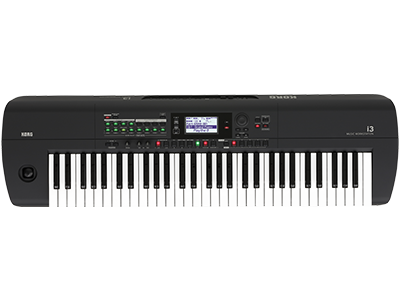i3
MUSIC WORKSTATION Product page
result:2
Pre-Purchase FAQ
Q
What type of sounds does the i3 have?
Q Can I add dynamics by playing keys hard or soft?
Q What are styles (automatic accompaniment)?
Q Can I play the i3 with the music from a portable music player or mobile phone?
Q What kind of music file can the i3 playback?
Q Does the i3 work with battery?
Q What kind of USB storage device does the i3 support?
Q What can I do using a USB flash drive?
Q Which pedal does the i3 support?
i3 contains a variety of over 700 sounds including pianos, violins, brass, basses, woodwinds and drums, as well as synth and other sounds used in the production of electronic and contemporary music.
Refer to
the specifications for further details.
Q Can I add dynamics by playing keys hard or soft?
The keys are touch-sensitive. You can select between Soft, Medium, Hard, and Fixed (i.e. no change) to suit your playing style.
Q What are styles (automatic accompaniment)?
Styles (automatic accompaniments) automatically add a "backing band" or rhythm accompaniment, and follow chords you play. The i3 contains over 280 accompaniment patterns covering a variety of genres including EDM and the latest contemporary music as well as jazz and Latin music.
Q Can I play the i3 with the music from a portable music player or mobile phone?
Yes, it's possible by connecting the player or phone to the Audio In jack.
Q What kind of music file can the i3 playback?
MP3, WAV, SMF (MIDI) can be played back on it. Please refer to
the specifications for further details.
Q Does the i3 work with battery?
It works with six AA batteries (alkaline, or nickel metal hydride).
Q What kind of USB storage device does the i3 support?
The i3 supports USB memory, disk, etc. formatted to FAT16 or FAT32. Please refer to
the specifications for details.
Q What can I do using a USB flash drive?
You can use it to save user song data that you recorded on the i3, or to play back various types of music file (SMF, WAV, MP3) while you play along on the keyboard.
Q Which pedal does the i3 support?
Damper pedal switch: Korg PS-1, PS-3
Half-damper switch: Korg DS-1H (i3 does not support the half-pedaling)
Expression pedal: Korg XVP-20, or EXP-2
Questions about playing keyboard
Q
How can I use the entire keyboard to play a single sound (e.g., grand piano)?
Q When I change sound sets, the split setting also changes.
Q The left-hand keys (the lower region of the keyboard) don't make sound.
Q No effect even when the ENSEMBLE button is turned on.
Q How can I adjust the volume balance between the keyboard performance and the accompaniment parts?
Q Some notes disappear.
Q The sound is not sustained when I hold down the pedal and release my fingers from the keyboard.
When you press the GRAND PIANO / SOUND button (lit red), all keys will play a recommended piano sound. You can also use the dial or the CATEGORY [<]/[>] buttons to switch to a different sound.
Q When I change sound sets, the split setting also changes.
Depending on the mute setting of the lower part, the split setting is switched automatically.
If the lower part is muted, split will be off.
If you want to turn split on, hold down the SHIFT button and press the LOWER/SPLIT part button to defeat mute.
Q The left-hand keys (the lower region of the keyboard) don't make sound.
If the lower part is not muted, the keys below the split point will play the lower part. Hold down the LOWER/SPLIT part button and turn the dial to check the volume level.
If split hold (a setting that maintains the split condition) is on, there will be no sound if the lower part is muted. Hold down the SOUND SET button and press the LOWER/SPLIT button to turn split hold off.
Q No effect even when the ENSEMBLE button is turned on.
It is necessary to play a chord. Confirm a chord is shown on the display by playing a chord in the chord recognition area.
Depending on the sound set that's selected, the ensemble function might be disabled, and in this case the setting cannot be changed.
Q How can I adjust the volume balance between the keyboard performance and the accompaniment parts?
Hold down the SOUND SET button and turn the dial to adjust. The adjusted balance can be saved in the set list.
Q Some notes disappear.
The maximum number of voices (notes that can be played simultaneously) is 64. It may exceed the limit when the damper pedal is used to sustain notes, and when this happens, some older notes will be cut off.
Q The sound is not sustained when I hold down the pedal and release my fingers from the keyboard.
Depending on the sound set / style performance that's selected, the pedal might be disabled, and in this case pressing the pedal won't have an effect.


